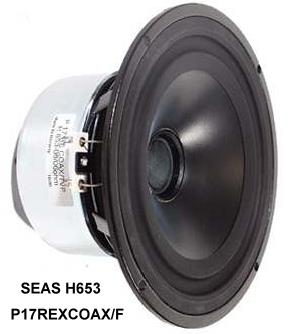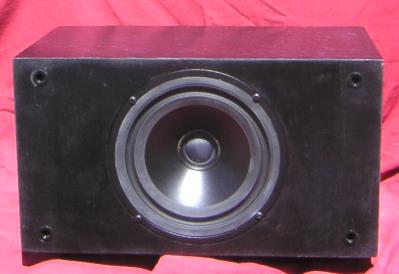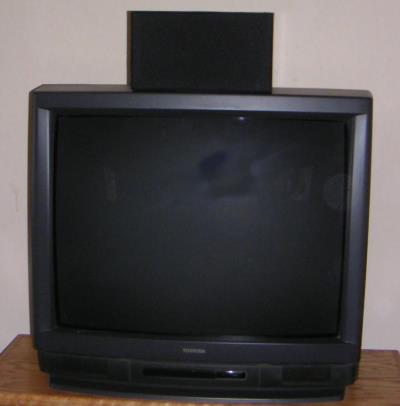 The
Seas Coax Center Channel
The
Seas Coax Center ChannelLast Update 16 May 2004
Back to Lou's Home Page
As my wife and I advance in years, we watch fewer shoot'em ups and more dramas. Too often I found myself turning up the volume on quiet passages, and cutting it down on louder scenes. Too often replaying the scene to hear the dialog.
Center channel (CC) speakers in the DIY arena are fairly scarce. From a strictly aesthetic and consistency standard, many wind up with an MTM on its side. The off axis problems of this arrangement are well documented. The alternatives are typically a single driver or a relatively massive three way design. I've historically used a TM sitting vertically (an ACI Emerald). It does a capable job, but it always looked like a chimney growing out of the top of the TV. I wanted a small, more aesthetically pleasing CC suitable for my 36" tube TV.
Seas makes three shielded coincident drivers. I selected the H653 driver as it requires the smallest box. It seemed like the perfect center. The coincident tweeter (in the center of the woofer) gives almost perfect alignment of acoustical centers. This driver should be a near perfect point source -- eliminating the lobing and cancellation effects of MTM and even TM designs. In theory, this should clarify dialog.
 So
all is perfect right? Not quite. The placement of the tweeter uses the
woofer for some horn loading, but it creates some wild cancellations in
the 10,000 hz area. I might be a little leery for purely music, but IMHO
this is relatively unimportant for a center channel. For the most part,
the effect disappears listening off axis.
So
all is perfect right? Not quite. The placement of the tweeter uses the
woofer for some horn loading, but it creates some wild cancellations in
the 10,000 hz area. I might be a little leery for purely music, but IMHO
this is relatively unimportant for a center channel. For the most part,
the effect disappears listening off axis.
After a bit of juggling, I came up with a 13.5"W x 7.5"H x 8"D box from 3/4 MDF. Net volume of about 470 cu in (7.6 liters). The box is tuned to 57 hz with two 1" D x 4" L, rear firing ports. I thought this size & shape would blend better with the TV.
I measured the prototype box on the edge of a table top, with a sheet of mdf below to simulate the final position on the TV. I hoped to pick up reflections in my measurements that mimicked the front of the TV.


I played with several models in LspCad but this one looked as smooth as any. I also built and tried three others with varying degree of baffle step correction (BSC). I thought this version was most suitable for center channel use. With almost no BSC, it emphasizes the midrange dialog that seemed to be lost with the TM had been using as a center. I beleve the BSC and warm voicing of the Emerald are very nice for music, but not especially good for CC. The coincident tweeter makes "textbook" crossovers possible -- a very easy driver to work with.
In my initital listening impressions, I definitely heard an improvement in dialog clarity and placement. I kept padding down the tweeter and stopped at 8 ohms -- though there is still a hint of sibilance. Since this also seems to be present in phantom mode (at least during my testing) I will attribute it to the source material. The sound is polite and clinical.
Overall, I think most will find this CC a definite improvement in clarity over MTM and TM designs. With this crossover, I don't think it would be optimal for stand alone use with music. The forward midrange that makes this appealing (to me) for center channel, would likely seem a bit "shouty" for standalone use. At $85 this driver isn't the cheapest CC around, but it could easily be built into a media cabinet if you choose.
 For
finishing, I used a 2 x 3 scrap of man made wooden veneer that was almost
white. Normally, I like "real wood" but I thought it would be
lost (and distracting) on top of the TV. So I created a black dye with
a hint of brown and thoroughly soaked the veneer. The effect is subtle
(and hard to photograph!) After a light sanding with 320 I was able to
expose enough of the veneer to pull some highlights out of the grain.
Five coats of water based Fuhr 355 gloss completes the finish.
For
finishing, I used a 2 x 3 scrap of man made wooden veneer that was almost
white. Normally, I like "real wood" but I thought it would be
lost (and distracting) on top of the TV. So I created a black dye with
a hint of brown and thoroughly soaked the veneer. The effect is subtle
(and hard to photograph!) After a light sanding with 320 I was able to
expose enough of the veneer to pull some highlights out of the grain.
Five coats of water based Fuhr 355 gloss completes the finish.
